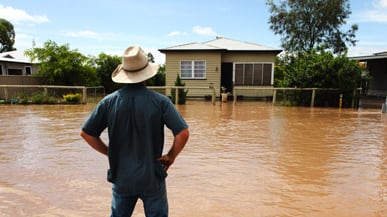Four weeks ago, Oprah Winfrey arrived in the northern Australian state of Queensland to film iconic foreign landscapes and fawning fans for her farewell season of daytime shows.
Winfrey’s working holiday was partially funded by the Queensland government. The state was hoping the Oprah television exposure might revitalize the tropical state’s appeal in the United States as a tourist destination in the same way that Australia’s Crocodile Dundee actor Paul Hogan once encouraged Americans to head Down Under and “throw a shrimp on the barbie”.
This week, Queensland got the international attention it wanted. But not in the manner it had desired.
ADVERTISEMENT
Photos: Flood Waters Recede in Brisbane

After a week of intense downpours that followed two months of almost constant rain, the state has endured its worst floods in recorded history. After eight consecutive years of drought, an area the size of Texas has now been declared a disaster zone within Queensland.
As of Friday, 16 people were dead and at least 55 others missing.
Many of the dead were swept away by what locals called an “inland tsunami”—a wall of water estimated by some to be up to 20 feet high. It was created when a freak storm dumped a foot of rain in less than an hour on the side of the nearby mountain range.
The runoff roared down into the valley catching residents of several hamlets unaware and swept many away as they sat inside their houses, businesses, and cars.
The wall of water was so ferocious that the roof of a farmhouse from one town was found in a tree in the next town—15 miles downstream. One body was located 45 miles away.
The Queensland capital of Brisbane, Australia’s third-largest city with a population of around two million, had three feet of muddy water through its central business district. Inundations were much higher in dozens of its suburbs which were left coated in thick-brown mud from the heavily silted floodwaters that had flowed down from the farmlands.
The wall of water was so ferocious that the roof of a farmhouse from one town was found in a tree in the next town.
At Dalby, a small town 300 miles west of Brisbane, the unrelenting rain flooded the township three times in two weeks, prompting some shattered residents to simply walk away rather than clean out their houses again.
At Rockhampton, a provincial city 1,000 miles north of the capital, another one-in-100 years rain system generated floodwaters that filled coal-mine shafts hundreds of feet deep, and bloated mine-tailing dams with their toxic contents spilling into nearby towns.
The horror stories of the floods were many:
• The mother and father who pushed their two children into the crawl space above the ceiling to escape the rapidly rising floodwaters, but were swept to their deaths before they could climb in themselves. • The dutiful son who left his safe haven to check his father’s flood-threatened property and was swept to his death down a stormwater drain. • The family, overjoyed that they were being rescued from the rooftop of their submerged house, who were suddenly plunged into grief when the turbulent waters tipped their 4-year-old son out of the rescue boat and swept him to his death.
And there were heroes, too:
• The tugboat driver who stopped a 300-foot long floating concrete-and-steel boardwalk from smashing into the pylons of the city’s major bridges. • The Baywatch-style lifeguards who drove from beach areas 60 miles away to use their rescue boats to ferry residents out of flooded homes. • The city workers who formed a human chain to pull passengers out of cars being washed away.
Queensland Premier Anna Bligh, a descendent of legendary Captain William Bligh, who survived after being set adrift in the South Seas by mutineers on the HMS Bounty in 1798, showed her own survival instincts.
“We are the people that they breed tough north of the border (with archrival state New South Wales),’’ she said as she played on the legendary parochialism of Queenslanders, who regard themselves as just a little tougher than the rest in a country that grew from a British convict colony.
“We’re the ones that they knock down and we get up again.’’
It was a defining moment for an embattled leader.
The floods came at a time when Bligh’s political stock had hit an all-time low. Her approval rating had slumped to below 30 percent, and with an election in 14 months, she was considered the lamest of lame ducks.
But in dealing with the natural disaster, Bligh didn’t make the same mistakes as President George W. Bush, who, in a controversial move, delayed his first visit to New Orleans after Hurricane Katrina and sparked the beginning of the end for FEMA Director Michael Brown with his, "Brownie, you're doing a heck of a job."
Instead the Queensland premier turned adversity into political gain while maintaining genuine compassion for her constituents.
She gave media conferences every two hours to keep the public and media informed. She chaired emergency meetings with her cabinet and disaster relief experts. She visited flooded residents to grieve with those who had lost a loved one.
And on two occasions, her voice wavered and she briefly shed a tear as she spoke of the crisis' human toll and emotional impact.
The rare show of emotion delivered instant political dividends. In one public poll in the 24 hours after her misty-eyed media briefing, Bligh’s approval rating had soared to 83 percent.
As the floodwaters begin to recede, estimates are that it could take up to two years to rebuild Brisbane and other parts of the state. The premier has assessed the clean-up and rebuilding task to be of “post-war proportions”.
The cost will be many billions of dollars at a time when Queensland has been selling off state assets in a bid to regain its valued AAA international credit-rating.
Already money markets have begun to adjust the Australian dollar, which in recent months has enjoyed parity with the greenback.
And other economic repercussions are likely to be felt well beyond the borders of Queensland and indeed Australia.
Queensland is the world’s largest seaborne exporter of coking coal, which is used in the steel-making process. Markets in China and India have looked on with concern, as floodwaters drowned mines, undercut critical railway lines and bridges, and left dozens of ships sitting idle outside seaports.
Queensland is also a world player in the export of sugar, wool, and organic beef and these industries have also been affected by the floods.
And then there’s tourism. As Australia’s Sunshine State with a climate similar to southern Florida, Queensland is known for the spectacular Great Barrier Reef, its pristine white sand beaches, and its laid-back lifestyle.
Tourism was the state’s second-most productive industry.
But in recent years, Australia’s popularity has waned with Americans as an international tourist destination with visits down by more than 15 percent from a decade ago.
Queensland has felt that rejection more than most with the downturn in visitor numbers resulting in the tourism industry dropping to No. 3 in the state’s income rankings as visitors from Japan and Europe are heading elsewhere.
Now the state’s appeal is expected to drop off even more from the media coverage of the floods.
On top of its reputation for deadly snakes, spiders, and sharks, foreign tourists who have seen coverage of the devastation in recent days couldn’t be blamed if they now see Queensland as a risky holiday destination of wild weather extremes.
The state’s once proud tourism slogan “Beautiful one day, perfect the next,” is now, well, dead in the water.
And it’s unlikely even a glowing daytime TV endorsement from Oprah can change that.
Ted Jefferies is a writer and resident of Brisbane, Australia.






